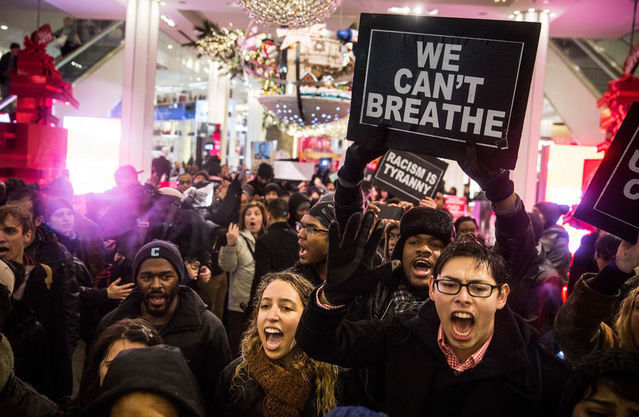 Demonstrators storm Macy's on 34th Street in NYC protesting the N.Y. grand jury's decision not to indict a police officer involved in the chokehold death of Eric Garner in July on Dec. 5, 2014. (Getty Images)
Demonstrators storm Macy's on 34th Street in NYC protesting the N.Y. grand jury's decision not to indict a police officer involved in the chokehold death of Eric Garner in July on Dec. 5, 2014. (Getty Images)
New York City saw a fourth night of protests Saturday over police violence against minorities, after the funeral for an unarmed black man who was killed by a police officer last month.
Akai Gurley, 28, was shot dead in a public housing stairwell November 20. Friends and family paid their last respects to him at a funeral in the New York borough of Brooklyn.
Rookie Police Officer Peter Laing shot Gurley in a stairwell of a Brooklyn apartment house project. Police said Gurley was not a crime suspect and was killed when the officer’s gun accidentally went off. But a New York newspaper reported that Laing waited before calling an ambulance immediately.
The Brooklyn district attorney said Friday that a grand jury would consider charges against Laing.
Demonstrators in New York ignored a cold December rain to protest Gurley’s death, as well as grand jury decisions not to indict white policemen responsible for the deaths of two other black men.
Protests were even more restrained than they were on Friday, when arrests fell to 20 from 200 on Thursday night.
“Seems to be the weather — it’s not really making it easy for them,” said a police officer in Times Square. He said he saw about 200 people march through the area, one of New York’s busiest shopping zones, during the afternoon.
A dozen protesters lay down again on the floor in New York’s Grand Central Terminal in one of the now-familiar “die-ins” featured in the recent wave of protests. Tourists and commuters stopped to watch the silent protest and snap pictures before going on their way.
“The fact that people are mobilizing is a great thing,” Amine Lazreg, 24, of Montreal said while sitting in a coffee shop in Times Square. “This type of protest is for social justice — I don’t know anyone who would go against that.”
Protesters and police alike showed restraint, and no major violence flared.
Other Cities
In Washington, demonstrators briefly blocked intersections as they moved across the city. Marchers also turned out in Detroit, Los Angeles, Houston and Seattle.
Demonstrations have occurred nightly since Wednesday, when a New York grand jury decided not to charge a white police officer, Daniel Pantaleo, in the chokehold death of unarmed black crime suspect Eric Garner.
In video of the incident, Garner, who was suspected of selling untaxed cigarettes, can be heard gasping, “I can’t breathe,” as police hold him on the ground.
The public outcry over the Garner case came after many Americans expressed outrage when a grand jury in Ferguson, Missouri, last month declined to indict a white policeman, Darren Wilson, for the shooting death of unarmed black teenager Michael Brown.
President Barack Obama has promised to address what he called the “simmering mistrust” between police and minorities, and U.S. Attorney General Eric Holder said the Justice Department was conducting federal civil rights investigations into Brown’s and Garner’s deaths.
Holder spoke in Cleveland, Ohio, where a police officer who reportedly had a poor performance record gunned down a 12-year-old black boy in a public park last month as he was waving what turned out to be a toy pistol.
‘Legitimate concerns’
U.N. human rights experts called for a review of police procedures in the United States in the wake of the Garner and Brown cases.
The grand jury decisions in the two cases “leave many with legitimate concerns relating to a pattern of impunity when the victims of excessive use of force come from African-American or other minority communities,” Rita Izsak, the U.N. special rapporteur on minority issues, said in a statement Friday.
Mutuma Ruteere, the U.N. special rapporteur on contemporary forms of racism, urged action in the face of what he called evidence of discriminatory practices, including racial profiling, by police officers.
“Such practices must be eradicated,” he said.
International law allows the use of lethal force only where absolutely necessary to protect life, said Christof Heyns, U.N. special rapporteur on extrajudicial, summary or arbitrary executions.
“The laws of many of the states in the U.S. are much more permissive, creating an atmosphere where there are not enough constraints on the use of force,” Heyns said. “A comprehensive review of the system is needed — the enabling laws, the kinds of weapons the police use, the training they receive and the use of technology such as on-body cameras to ensure accountability.”
—
Related:
UN Experts Urge Review of US Police Practices (Video: Day 3 of NYC Protests)
New York to Retrain Police in Wake of Chokehold Death Case (VOA News)
Protesters flood New York City in second night of demonstrations (NY Daily News)
New Inquiry Needed on Eric Garner’s Death (NYT)
Join the conversation on Twitter and Facebook.

























